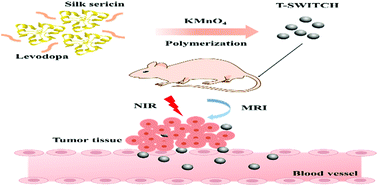Single-step formulation of levodopa-based nanotheranostics – strategy for ultra-sensitive high longitudinal relaxivity MRI guided switchable therapeutics†
Abstract
Nanotheranostics (combined diagnosis and therapy) is emerging as an integral part of future therapeutic strategies. However, the development and fabrication of a nanotheranostic module involves multistep processes and always faces formulation challenges. The complexity involved in its multi-step formulations hinders its reproducible industrial production and clinical translation. Therefore, a facile synthesis of multifunctional nanotheranostics is critical to its translational success. In this report, we have developed a one-pot facile strategy to prepare a MRI-visible photothermal theranostic switchable module (T-SWITCH). These nanoparticles are synthesized through polymerization of levodopa together with the reduction of KMnO4 in the presence of silk sericin for the formation of manganese dioxide particles within the T-SWITCH. The synthesized T-SWITCH showed a uniform size distribution of around 95.77 nm and high longitudinal relaxivity coefficient (r1) of up to 61.94 mM−1 s−1. The reported r1 of the T-SWITCH is exceedingly higher than that of any other previously reported manganese-based contrast agents with first-rate in vitro and in vivo contrast enhancement capability. The T-SWITCH can be activated to switch its therapeutic mode using near-infrared (NIR) light. It exhibited strong excitable absorption in the safer and biological NIR window between 650 and 900 nm. We have validated the significant anti-cancer therapeutic efficacy of T-SWITCH both in vitro and in vivo through switchable photothermal therapy.



 Please wait while we load your content...
Please wait while we load your content...